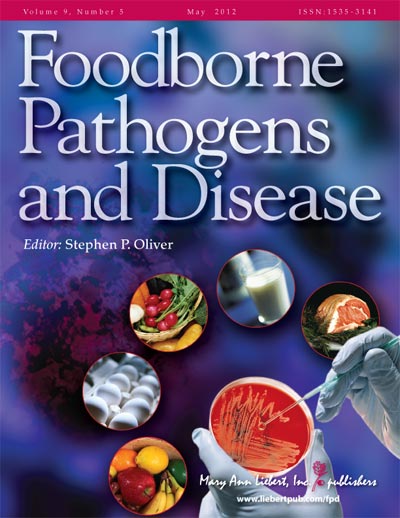View Item
- xmlui.general.dspace_homeCentros e Institutos de InvestigaciónCIA. Centro de Investigaciones de AgroindustriaInstituto de Tecnología de AlimentosArtículos científicosxmlui.ArtifactBrowser.ItemViewer.trail
- DSpace Home
- Centros e Institutos de Investigación
- CIA. Centro de Investigaciones de Agroindustria
- Instituto de Tecnología de Alimentos
- Artículos científicos
- View Item
Subtyping of Escherichia coli O157:H7 Strains Isolated from Human Infections and Healthy Cattle in Argentina
Abstract
Shiga toxin–producing Escherichia coli (STEC) cause nonbloody (NBD) and bloody diarrhea (BD), and hemolytic uremic syndrome (HUS). Cattle have been described as their main reservoir. STEC O157:H7 is recognized as the predominant serotype in clinical infections, but much less is known about the dominant subtypes in humans and animals or their genetic relatedness. The aims of this study were to compare the STEC O157 subtypes found in sporadic human
[ver mas...]
Shiga toxin–producing Escherichia coli (STEC) cause nonbloody (NBD) and bloody diarrhea (BD), and hemolytic uremic syndrome (HUS). Cattle have been described as their main reservoir. STEC O157:H7 is recognized as the predominant serotype in clinical infections, but much less is known about the dominant subtypes in humans and animals or their genetic relatedness. The aims of this study were to compare the STEC O157 subtypes found in sporadic human infections with those in the bovine reservoir using stx-genotyping, phage typing, and XbaI– pulsed-field gel electrophoresis (PFGE), and correlate the subtypes with the severity of clinical manifestations. The 280 STEC O157:H7 strains collected included in this study were isolated from HUS (n = 122), BD (n = 69), and NBD (n = 30) cases, and healthy carriers (n = 5), and from bovines (n = 54) in the abattoirs. The stx-genotyping showed that stx2/stx2c(vh-a) was predominant in human (76.1%) and in bovine strains (55.5%), whereas the second more important genotype was stx2 (20.8%) in human and stx2c(vh-a) (16.7%) in cattle strains. In human strains, PT4 (37.6%), PT49 (24.3%), and PT2 (18.6%) were the most frequent PTs (80.5%). In bovine isolates, PT2 (26%), PT39 (16.7%), and PT4 and PT49 (11.1% each) were predominant. By XbaI-PFGE, all 280 strains yielded 148 patterns with 75% similarity, and 169 strains were grouped in 37 clusters. Identical PT-PFGE-stx profile combinations were detected in strains of both origins: PT4-AREXH01.0011-stx2/stx2c(vh-a) (12 humans and one bovine), PT4-AREXH01.0543-stx2/stx2c(vh-a) (one human and four bovines), PT2-AREXH01.0076-stx2/stx2c(vh-a) (one human and four bovines), PT49-AREXH01.0175-stx2/stx2c(vh-a) (seven humans and one bovine), and PT49- AREXH01.0022-stx2/stx2c(vh-a) (seven humans and one bovine). No
correlation was found among the stx-genotypes, the phage type, and the clinical symptoms.
[Cerrar]

Author
Del Castillo, Lourdes;
D’Astek, Beatriz A.;
Miliwebsky, Elizabeth;
Carbonari, Claudia Carolina;
Palladino, Pablo Martin;
Deza, Natalia;
Chinen, Isabel;
Manfredi, Eduardo;
Leotta, Gerardo A.;
Masana, Marcelo Oscar;
Rivas, Marta;
Fuente
Foodborne Pathogens and Disease 9 (5) : 457-464 (2012)
Date
2012-05-02
Editorial
Mary Ann Liebert, Inc.
ISSN
1535-3141
1556-7125
1556-7125
Formato
pdf
Tipo de documento
artículo
Palabras Claves
Derechos de acceso
Restringido
 Excepto donde se diga explicitamente, este item se publica bajo la siguiente descripción: Creative Commons Attribution-NonCommercial-ShareAlike 2.5 Unported (CC BY-NC-SA 2.5)
Excepto donde se diga explicitamente, este item se publica bajo la siguiente descripción: Creative Commons Attribution-NonCommercial-ShareAlike 2.5 Unported (CC BY-NC-SA 2.5)

